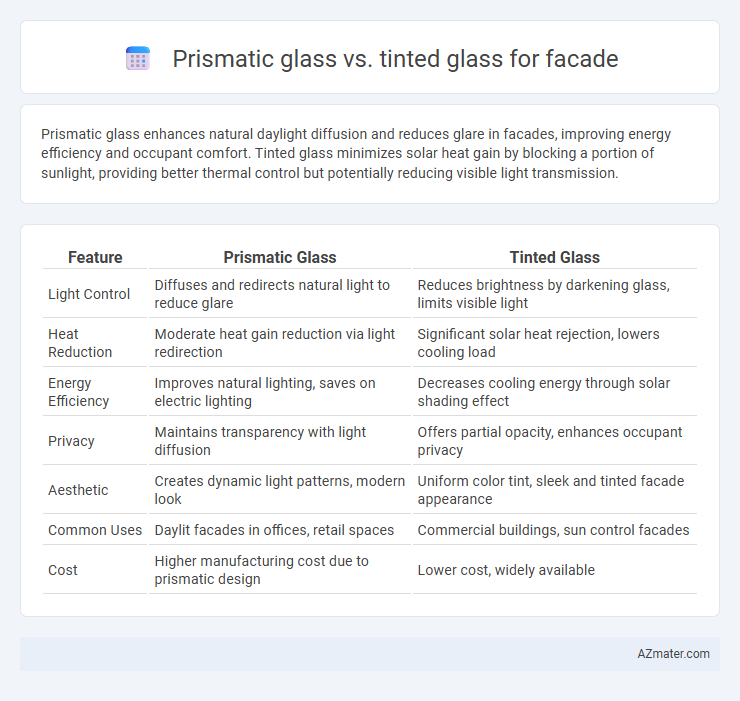Prismatic glass enhances natural daylight diffusion and reduces glare in facades, improving energy efficiency and occupant comfort. Tinted glass minimizes solar heat gain by blocking a portion of sunlight, providing better thermal control but potentially reducing visible light transmission.
Table of Comparison
| Feature | Prismatic Glass | Tinted Glass |
|---|---|---|
| Light Control | Diffuses and redirects natural light to reduce glare | Reduces brightness by darkening glass, limits visible light |
| Heat Reduction | Moderate heat gain reduction via light redirection | Significant solar heat rejection, lowers cooling load |
| Energy Efficiency | Improves natural lighting, saves on electric lighting | Decreases cooling energy through solar shading effect |
| Privacy | Maintains transparency with light diffusion | Offers partial opacity, enhances occupant privacy |
| Aesthetic | Creates dynamic light patterns, modern look | Uniform color tint, sleek and tinted facade appearance |
| Common Uses | Daylit facades in offices, retail spaces | Commercial buildings, sun control facades |
| Cost | Higher manufacturing cost due to prismatic design | Lower cost, widely available |
Introduction to Glass Facade Technologies
Prismatic glass and tinted glass represent two prominent technologies in the evolution of glass facades, each enhancing building performance differently. Prismatic glass utilizes micro-structured patterns to manipulate natural light, increasing daylight penetration while reducing glare and solar heat gain, thus improving energy efficiency. Tinted glass, infused with color pigments or metallic oxides, primarily controls solar radiation by absorbing or reflecting sunlight, offering effective thermal management and privacy without compromising visibility.
What is Prismatic Glass?
Prismatic glass is engineered with micro-structured surface patterns that refract and diffuse natural light, enhancing daylight distribution within building interiors. Unlike tinted glass, which reduces solar heat and glare by absorbing light, prismatic glass optimizes light transmission while minimizing direct sunlight, improving energy efficiency and occupant comfort. Its unique optical properties make prismatic glass ideal for facades seeking to maximize natural lighting without compromising on thermal performance.
Key Features of Tinted Glass
Tinted glass for facades offers enhanced solar heat control by reducing glare and blocking a significant portion of ultraviolet (UV) rays, which helps in maintaining indoor comfort and protecting furnishings from fading. It typically features uniform coloration that varies in intensity, allowing for aesthetic customization while improving energy efficiency by lowering cooling costs. Compared to prismatic glass, tinted glass provides consistent light reduction without refracting light, making it ideal for buildings requiring privacy and minimal visual distortion.
Aesthetic Differences: Prismatic vs Tinted Glass
Prismatic glass enhances facades with its dynamic light refraction, creating vibrant patterns and a multidimensional appearance that changes throughout the day. Tinted glass offers a uniform, subdued color tone, providing consistent shading and a sleek, modern look. While prismatic glass emphasizes visual complexity and movement, tinted glass prioritizes subtlety and energy efficiency through controlled solar heat gain.
Light Transmission and Daylighting Performance
Prismatic glass enhances daylighting performance by diffusing sunlight and increasing light transmission without causing glare, making it ideal for optimizing natural light in facades. Tinted glass reduces light transmission by absorbing a portion of solar radiation, which lowers heat gain but can compromise daylight quality and indoor illumination. Selecting prismatic glass over tinted glass improves energy efficiency and visual comfort through better daylight distribution in building facades.
Energy Efficiency: Comparing Prismatic and Tinted Glass
Prismatic glass enhances energy efficiency by optimizing natural daylight distribution, reducing reliance on artificial lighting and lowering cooling loads through controlled solar heat gain. Tinted glass primarily minimizes solar heat gain by absorbing and reflecting sunlight, which can reduce cooling costs but also limits visible light transmission, potentially increasing lighting needs indoors. Overall, prismatic glass balances daylight utilization with thermal control better than tinted glass, making it a superior choice for sustainable facade design.
UV Protection and Glare Control
Prismatic glass offers superior UV protection by diffusing and redirecting sunlight, reducing harmful ultraviolet radiation penetration while enhancing natural daylight distribution. Tinted glass primarily reduces glare and heat by absorbing solar energy, which lowers visible light transmission and minimizes discomfort from direct sunlight. For facade applications requiring optimal UV protection and glare control, prismatic glass provides advanced light management without compromising exterior visibility.
Impact on Building Sustainability
Prismatic glass enhances building sustainability by maximizing natural daylight penetration, reducing the need for artificial lighting and lowering energy consumption. Tinted glass primarily limits solar heat gain, which helps maintain indoor temperature and reduces cooling loads, thereby improving energy efficiency. Combining prismatic and tinted glass technologies can optimize daylight utilization and thermal regulation, resulting in a significant reduction in the building's overall energy footprint.
Cost Considerations and Installation Factors
Prismatic glass generally incurs higher upfront costs than tinted glass due to advanced manufacturing techniques and specialized coatings designed to optimize light diffusion and energy efficiency. Installation of prismatic glass demands skilled labor to ensure proper alignment and sealing, which can increase labor expenses and time on site compared to the more straightforward installation of tinted glass. Tinted glass offers cost savings with simpler installation and lower material costs but may provide less control over daylight harvesting and solar heat gain reduction than prismatic alternatives.
Choosing the Right Glass for Your Facade
Prismatic glass enhances natural daylight distribution and reduces glare, making it ideal for energy-efficient facades with improved indoor comfort. Tinted glass reduces solar heat gain and glare by absorbing sunlight, helping to maintain cooler interior temperatures in hot climates. Choosing the right glass depends on factors like climate, building orientation, and desired energy performance, with prismatic glass best suited for maximizing daylight and tinted glass preferred for heat reduction.

Infographic: Prismatic glass vs Tinted glass for Facade
 azmater.com
azmater.com